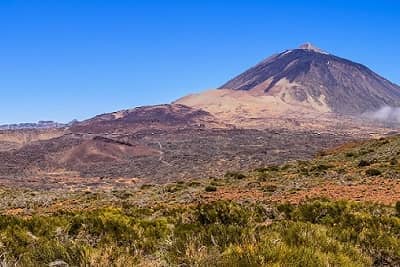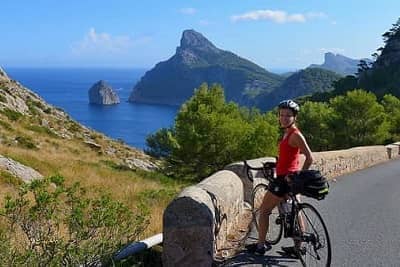Gran Canaria Cycling Climbs
| Climb | Town | Altitude (m) | Length (km) | Gradient (%) | Difficulty | Rating |
|---|---|---|---|---|---|---|
| Cruz de Tejeda | Tamaraceite | 1516 | 21.5 | 5.8 | 980 | *** |
| Cruz de Tejeda | Tamaraceite | 1517 | 23.5 | 4.9 | 1084 | **** |
| El Aserrador | La Aldea de San Nicolas | 1424 | 23.4 | 5.5 | 1318 | **** |
| El Aserrador | Puerto de Mogán | 1425 | 37.0 | 3.8 | 687 | **** |
| Ayagaures | Maspalomas | 490 | 12.5 | 3.3 | 124 | *** |
| Ayagaures | Maspalomas | 490 | 8.0 | 5.3 | 145 | *** |
| Cenobio de Valeron | El Pagador | 261 | 5.6 | 4.3 | 98 | *** |
| El Sao | Agaete | 515 | 9.3 | 5.0 | 156 | **** |
| Guayadeque | Aguimes | 955 | 8.7 | 7.6 | 679 | *** |
| Mogán | Puerto de Mogán | 645 | 19.0 | 3.0 | 370 | *** |
| Mogán | La Aldea de San Nicolas | 660 | 9.0 | 5.6 | 495 | *** |
| Mogán | Playa de Tasarte | 676 | 12.0 | 5.4 | 445 | *** |
| Pico de las Nieves | Arucas | 1938 | 35.5 | 4.8 | 1105 | **** |
| Pico de las Nieves | Carrizal | 1938 | 26.6 | 6.8 | 1655 | **** |
| Pico de las Nieves | Ayacata | 1938 | 11.5 | 5.2 | 574 | **** |
| Pico de las Nieves | Tejeda | 1938 | 15.5 | 5.6 | 787 | **** |
| Pico de las Nieves | Telde | 1938 | 26.2 | 6.8 | 1346 | **** |
| Pinos de Gáldar | El Pagador | 1542 | 28.0 | 5.3 | 985 | *** |
| Pinos de Gáldar | Gáldar | 1542 | 26.9 | 4.9 | 1025 | **** |
| Pinos de Gáldar | Guía | 1542 | 30.0 | 4.5 | 935 | *** |
| Pinos de Gáldar | La Aldea de San Nicolas | 1542 | 34.4 | 4.4 | 1119 | **** |
| Pinos de Gáldar | Risco Caído | 1542 | 10.5 | 6.5 | 625 | *** |
| Risco Grande | Argeneguín | 920 | 9.0 | 7.7 | 590 | **** |
| Roque Bentayga | El Chorrillo | 1180 | 7.7 | 7.3 | 444 | **** |
| San Bartolomé | Maspalomas | 975 | 20.0 | 4.1 | 795 | **** |
| San Bartolomé | Vecindario | 976 | 23.0 | 3.2 | 385 | **** |
| Tamadaba | Agaete | 554 | 6.3 | 7.5 | 400 | **** |
| Temisas | Aguimes | 825 | 12.0 | 4.5 | 365 | **** |
Mountains
Gran Canaria is a great cycling destination for riders who enjoy climbing. There are many great routes around the island, with climbs of all different lengths and gradients.The highest mountains are in the very center of the island. Here you will find the volcanic peak known as Pico de las Nieves, as well as the iconic Roque Nublo. There are also excellent climbs to be found on the west coast, particularly around the villages of Agaete and La Aldea de San Nicolas. The climbs here are not quite so high, but are situated on top of coastal cliffs, such as the Tamadaba Natural Park, with excellent views looking out to sea.
The east of the island around Las Palmas and the airport is more built up and generally not so good for cycling. However, a little in land, around the town of Aguimes there are more fantastic climbs, heading up to picturesque villages like Santa Lucía, and Tejeda.
Scenery
The scenery is spectacular and incredibly diverse throughout Gran Canaria. The northern and western sides have a more tropical Atlantic climate. Here there is beautiful green scenery and you will ride between banana plantations, exotic fruit orchards and even fields of coffee. The vibrant green colours have a great contrast with the reddish volcanic soils and the blue ocean.The southern and eastern parts of Gran Canaria are more influenced by the nearby Sahara Desert. In places they are very dry, with dramatic rock formations and even large sand dunes around Maspalomas. The roads here snake up through steep sided cliffs, providing impressive views looking both to the sea and towards the high mountains of the center.
Roads
The road surfaces are generally in very good condition. Every now and again there is a rough section where the road has suffered from rock fall or landslides, but generally it's very enjoyable for riding on a road bike.Most of the traffic is situated around the north-east of the island (close to capital Las Palmas), and around the resort towns of the south coast (Maspalomas). However, with a bit of research, it's easy to find quiet roads, and the drivers on the island are very courteous towards cyclists.
Getting There
Gran Canaria is easy to get to from almost all countries in Europe. It has only one airport, which is located half way between Las Palmas and Maspalomas on the east of the island.Several low cost airlines fly here, and most will happily carry your bike for an extra charge.
There is also a ferry that connects Gran Canaria with the Spanish mainland (with two different lines operating between Cadiz/Huelva and Las Palmas). Ferries can also easily be caught between the different Canary Islands.
Currently there is no ferry running from Morocco, although there are plans to establish a link in the near future.
Weather
Gran Canaria has a sub-tropical climate, with little variation in temeprature throughout the year. This makes the Canary Islands probably the best place in Europe to cycle during the winter, when daily temperatures are usually above 20°C.Rain is also uncommon, particularly in the winter. Showers are more likely in the north of the island - but don't let this put you off cycling there as it is generally a dry climate. After all - the island is only a few hundred kilometres from the Sahara Desert!
Cycling Holidays
Our Best of Canaria cycling holiday tackles the best climbs and most scenic routes on the island.It is a multi-centered tour which crosses almost the entire length and width of Gran Canaria, allowing you to really get to know the diverse parts of the island. You can find out more details about this and similar tours that we run in the links below.
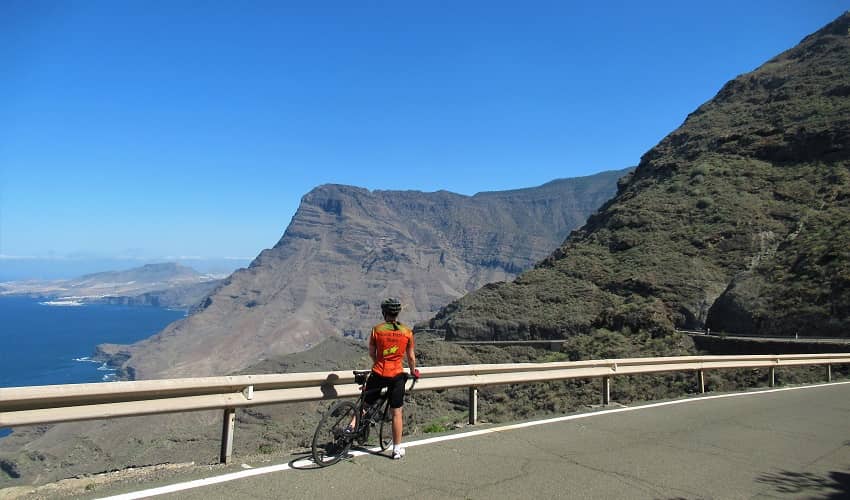
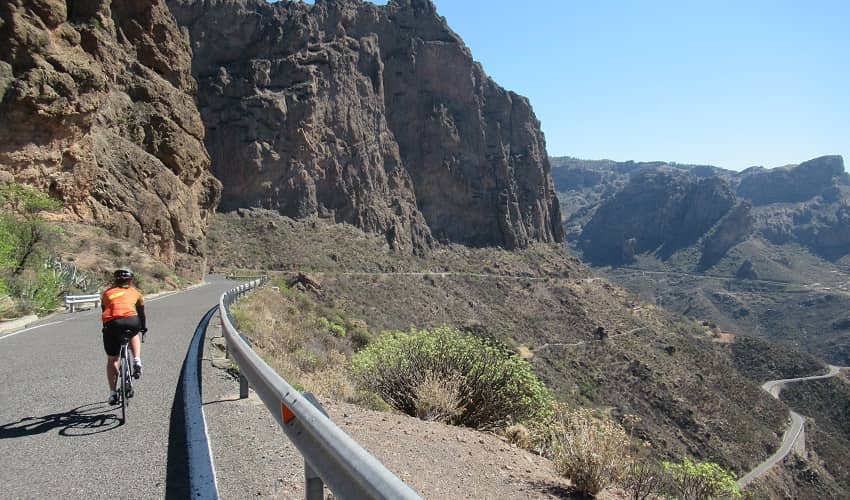
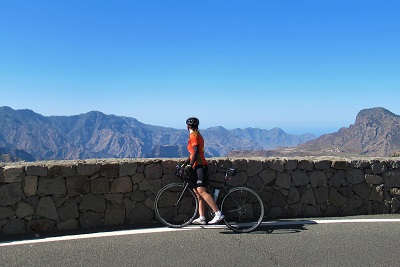
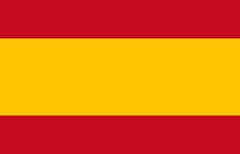 Spain
Spain
